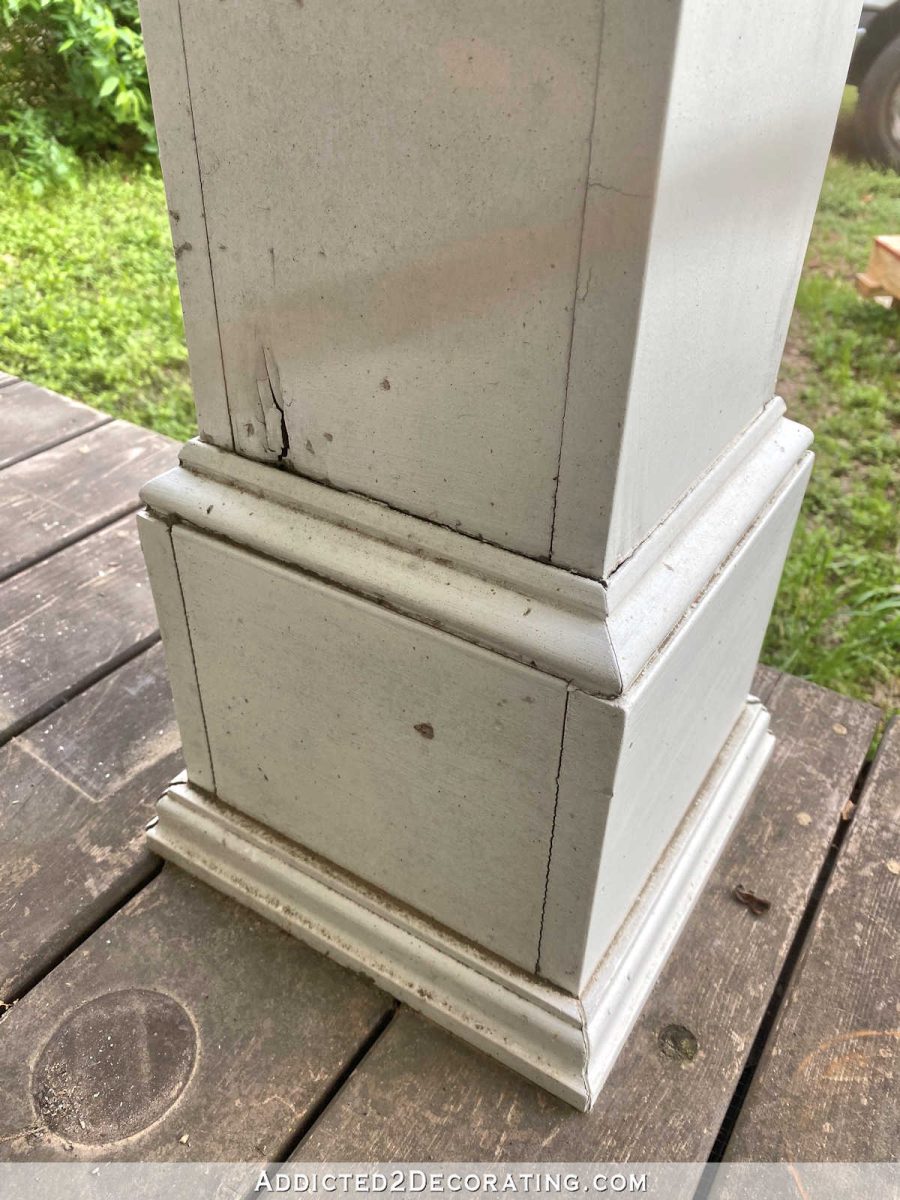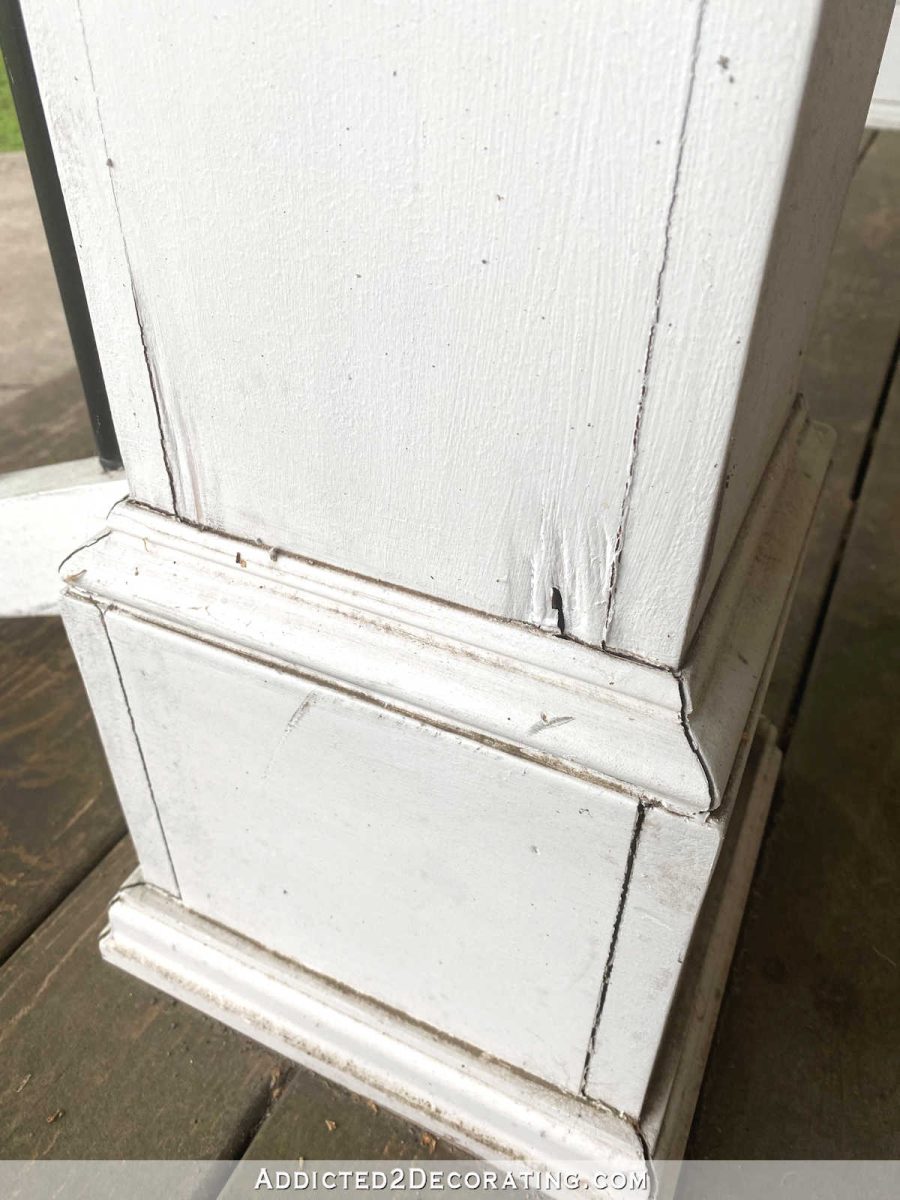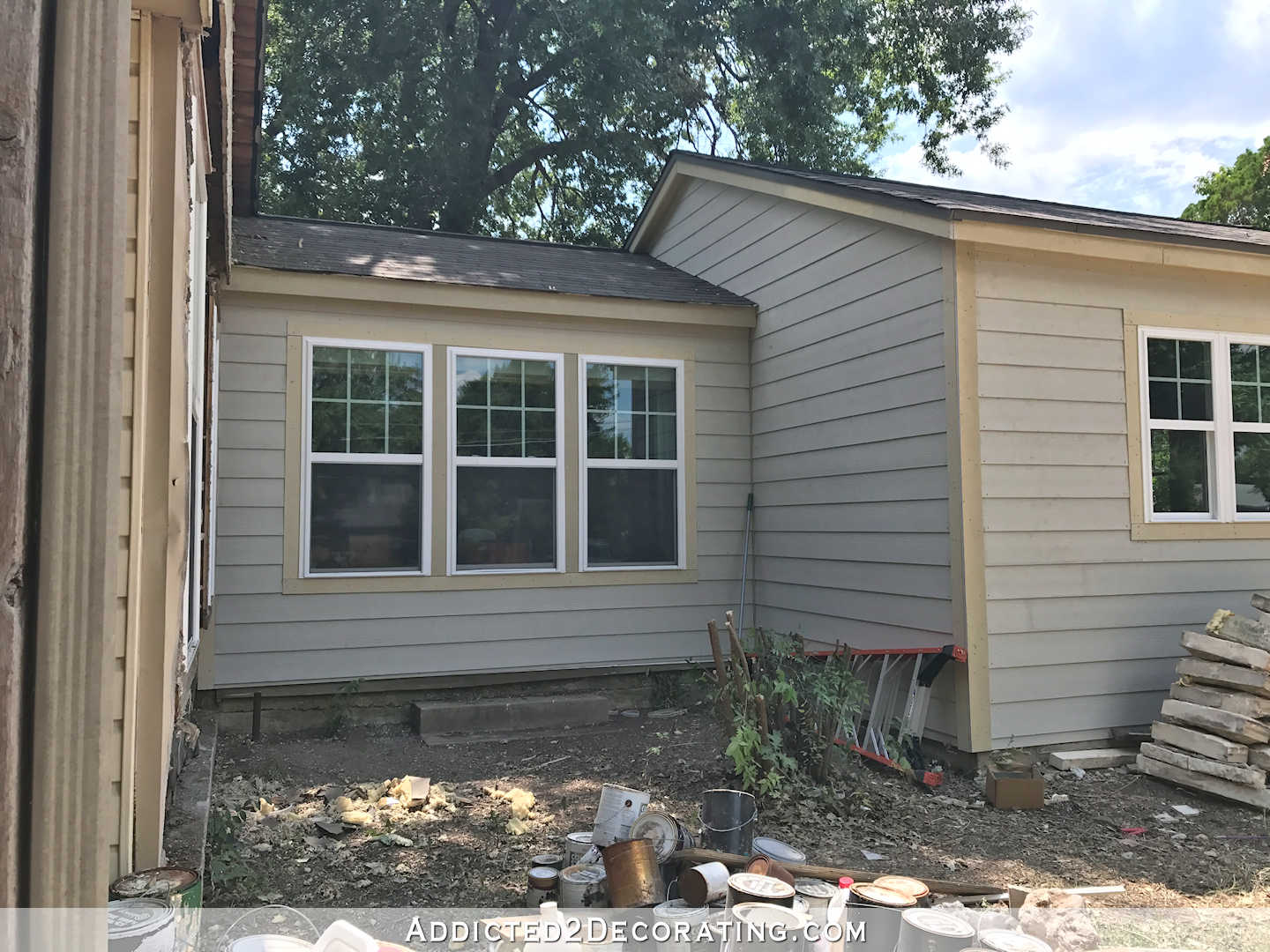PVC Boards vs. Real Wood For Outdoor Projects (How Each Has Held Up On My Front Porch?)
It’s been about three-and-a-half years since I finished the front porch transformation. (I’m not really sure what to call it. A remodel? That sounds weird, but it was a whole heck of a lot more than a makeover.) On that front porch transformation, I used real wood for most of it, and then used PVC boards for part of it. So how have they held up? How have the real wood trim boards stood up to the weather and exposure compared to the PVC boards?
I’ll show you. But first, let’s back up and remember how this porch started out when we bought the house…

Yeah. It needed some love and attention, and a whole lot of work. 😀
So in 2018, I set out to update the front porch by covering the concrete with a stained cedar front porch, replacing and then beefing up the supports, and then building new steps with handrails. Here’s what it looked like when I got through with all of that, along with having new siding, a new front door, and new windows installed.

I shared with y’all a few months back about how the stain/sealer that I used on the cedar porch has held up (or hasn’t). The snails and slugs have wreaked havoc on the finish. You can see every place where they slither because their slimy little bodies seem to eat right through the sealer. So my front porch and steps are covered with these little snail and slug trails all over.

But other than needing a new coat or two of stain/sealer, the cedar boards have held up very well. I don’t see any rot or other issues with the actual integrity of these boards at all.
So I’ve been looking forward to the weather getting nicer (as in, getting past our rain and tornado season) so that I can get out there and spend some time sanding and re-sealing the front porch. And part of sprucing up the front porch would include getting out the power sprayer and getting the winter dirt and grime off of everything.
But as I was looking over the front porch this weekend to take note of everything I need to do out there (including finally finishing the stone facade on concrete porch skirting), I noticed that I have a bigger problem on my hands than snail trails through the porch sealer. I’ve also got places on all three columns that look like this…

Here’s another area…

And yet another one…

When I started that project, it didn’t even occur to me to use anything other than real wood lumber. So that’s what I did. I figured that all I needed to do was prime it really well with oil-based primer, and then give it two or three coats of exterior paint, and it would last forever. Clearly, I was wrong.
By the time I got around to building the steps and the handrails, I had decided to use PVC boards instead (probably because one of you suggested it to me). So I used PVC boards and put them together using the PVC glue that basically bonds them together and makes them all one piece, and they still look great three-and-a-half years later. None of the joints have expanded or separated, and other than being covered with winter dirt and grime that needs to be washed off, they look pretty darn perfect.

My shutters, which I also made out of PVC boards, have also held up perfectly.

And no, I never finished painting that window trim, so it needs to be done this year as well.
So I could handle those columns in two ways. First, I could use wood filler that is made for outdoor use, fill in those areas on the columns and sand them smooth, caulk any gaps, and then prime again with oil-based primer, and paint again with exterior paint. There’s nothing wrong with that solution. In fact, I’ve seen many people restoring old homes where the windows are trimmed with real wood that has started rotting, and this is exactly how they handle it.
Or, while I’m taking the time to sand and reseal the front porch, I could also take some time to replace those real wood board with PVC boards that would probably last forever and would almost never require upkeep.
I’m not quite sure at this point which option I’ll go with. If I choose the first, then I could probably get three more years out of them before having to do the same type of maintenance on them again. But at some point, I probably will want to replace them with PVC. I mean, at some point, I will reach an age where I don’t want to have to do that type of maintenance on my house when I can use a maintenance-free product and take care of it once and for all. So, we’ll see.
But regardless of which option I choose, I really want to get this porch finished this year. I want to get the cedar boards resealed, get the skirting finished, and finally get some nice chairs for the porch and make it look inviting.
Addicted 2 Decorating is where I share my DIY and decorating journey as I remodel and decorate the 1948 fixer upper that my husband, Matt, and I bought in 2013. Matt has M.S. and is unable to do physical work, so I do the majority of the work on the house by myself. You can learn more about me here.








Was the wood trim on the columns caulked originally? Did it fail?
I would replace everything with PVC now rather than wasting all the time, effort, and expense to try to restore the old wood trim, just to need to do it again down the road. One and done.
Yes, everything was caulked originally. I think we just get too much humidity here, making the boards expand and contract too much, for the caulk that I used to hold. Plus, when everything was new, all of the joints were very tight, requiring very little caulk. So there wasn’t really enough caulk there to expand as the wood expanded. Not sure if that makes sense. 😀 I’ll probably use Big Stretch for all outdoor projects from here on out.
For selfish reasons I hope you decide to go the wood filler route so I can see it in action before tackling my own, haha, but it sounds like the PVC boards would be a better investment for you.
I’m also very curious to see what stain/sealer you use for the cedar this time. My house came with a playset and while I have no kids, I also don’t want to remove it since I plan to sell in a few years & the future owners may enjoy it. It was re-stained a few years ago & unfortunately hasn’t held up well at all, so I’ve been wondering what product to try this time around. Real-world examples are always so helpful when making decisions like this!
If it’s a financial decision, I’d go with fixing them and replacing later on. They’re not so bad that some maintenance wouldn’t help. I think that’s the best at this time.
We put Azek composite down on our 3-sided front porch and Azek railing on the 3rd floor walkout. I love them, once we finish a job, I hate going back and re-doing it again a few years later. Our house was built in 1886.
So an overthinking thought, and can be wrong. Look into having some extra drainage. Ways for water to add a weep hole or flashing, if cladding with PVC. It clearly holds up well, but could hold in a lot of moisture against the columns. So having a few protected places to allow minimal air in and allow moisture out would be good.
Your idea of the oil based primer was good but you needed to go one step further. What would have made the wood hold up better is if you’d have primed the entire piece of wood. Front, back and all edges. It’s the unprimed edges that are soaking up the water. Also fill in the nail holes w/a dab primer. Learned the little bit when we replaced a porch floor on an old house.
Go with the PVC boards, and you won’t be wasting money, time and effort on repairing something that will need to be repaired again. Just my two cents worth!
My opinion (for the whole 2 cents it is worth) – I approach this from a financial/time POV. Questions to ask yourself:
First, do you have the funds and time to rip & replace with PVC right now?
Will the spend of money and time replacing get in the way of other more pressing projects like the master bath or home gym?
Is it more cost effective from a time & materials standpoint to salvage what you have for now and do the replacement in a few years?
If you, like me, have limited funds and time, it may make more sense to stretch the life of what you have to get bigger, more pressing projects done first and replace with PVC the next time around when you have more flexibility in terms of money and time. Only you can know the answers to these questions and I certainly don’t expect you to tell me, some stranger on the internet. 😀
However, if you can afford to do the replacement, I am a huge believer in “one and done”, but I also don’t believe that extending the life of things you’ve already spent money and time on is wasteful if it allows you to achieve other things that have been waiting their turn.
All costs being equal, one and done wins in my book.
Also, I look forward to your every post. It is fascinating to see how you transform your home. Good luck deciding what to do.
I love your idea of using PVC to make your shutters. I’ve never put shutters on my front windows simply because I never found any I liked well enough. Now with seeing that you used PVC, I think I will make my own now. Glad I read this.
I’d go ahead and do the PVC route. Why waste the time? If you were restoring a 100 year old house and trying to stay “original”, that would be different. But you already have PVC on the exterior, you have the know how, you have the time, you have the ability, I think you have the money (?)… Bite the bullet, do it this one time, and future you won’t be kicking past you in the rear end for creating such a hassle. ;~)
I don’t know what kind of wood was used to build out the columns, but wood species makes a huge difference in how long it lasts.
Pine doesn’t hold up well outdoors unless it is treated. Fir is a better choice, but more expensive (and also better when treated). Redwood or Cedar are the best as they are naturally rot resistant. Of course they are the most expensive. Especially nowadays.
In addition to weep holes, it’s also important to prime both sides because moisture can attack from the backside as well as the front.
A lot of retailers sell finger jointed lumber which they claim is good for outdoors, but often the finger joints don’t expand and contract with the wood and they end up being very visible through the primer and paint.
PVC deckboards are the same issue. Hands and knees to restore them or PVC once. I’m sure there a lot more fun things you could be doing. Also a better first impression may help with any clients you may invite to your home. I don’t know if all brands stain but one I used first hand leaf shaped stains where a wet leaf had sat over time. The next one I used didn’t stain and I wish I knew which brand was which.